Three laps, 400 meters in total, and a crowd in the middle of Vienna’s University Hospital Campus. This was the Cybersportdays, held alongside the 15th International Workshop on Functional Electrical Stimulation (FES). For us at PULSE Racing, it was more than just a race weekend, it was the end of our academic year and the beginning of a new academic year with new challenges. One of the best things about events like this is the community feeling. We finally had the chance to meet the Austrian ViennaFES and Hungarian HunFess teams in person again, to talk training, compare bike set-ups, and just learn from each other. As Peter van Burk put it after his races:
“The FES-community will advance faster if we all learn from each other. That’s why we should keep coming together at events like this. The competitive race format really helps the teams push the limits of what’s possible (…) and it motivated me to get in the best shape I could.” What does a FES Cycling Race look like?
A FES cycling race looks similar to other handcycling races. But there is a slight difference: all athletes have a complete spinal cord injury. They cannot feel or move their legs by themselves. And that’s also where the secret lies: electrodes are placed on the big muscle groups of the legs, small electrical pulses are delivered to paralyzed muscles, making them contract and power the cycling movements. It’s not as simple as “switching the legs on”. The muscles are just not controlled by the brain, but they fatigue and have to be trained the exact same way as if they were. The main principle is: Use it or Lose it. If the muscles are not activated by the electrical pulses, muscle atrophy will kick in and the muscle will start to lose power and strength; just like when able bodied people stop working out. Nevertheless, it should be mentioned that this muscle atrophy takes place a lot quicker in people with spinal cord injuries. During FES cycling, athletes must carefully balance stimulation intensity, timing, and gear choice on tracks. Push too hard at the start, and the muscles fatigue. Pace too slowly, and you lose the race.
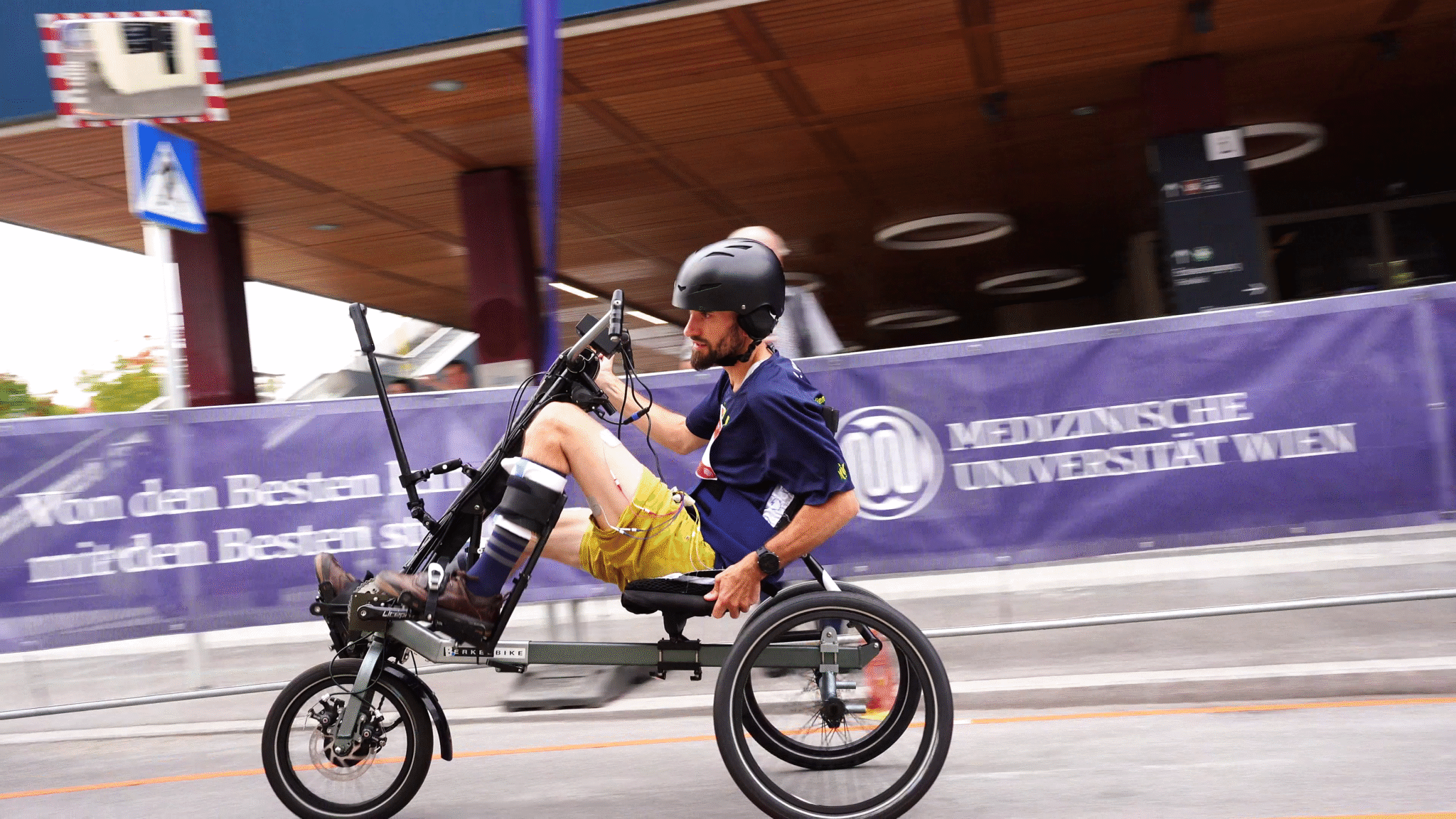
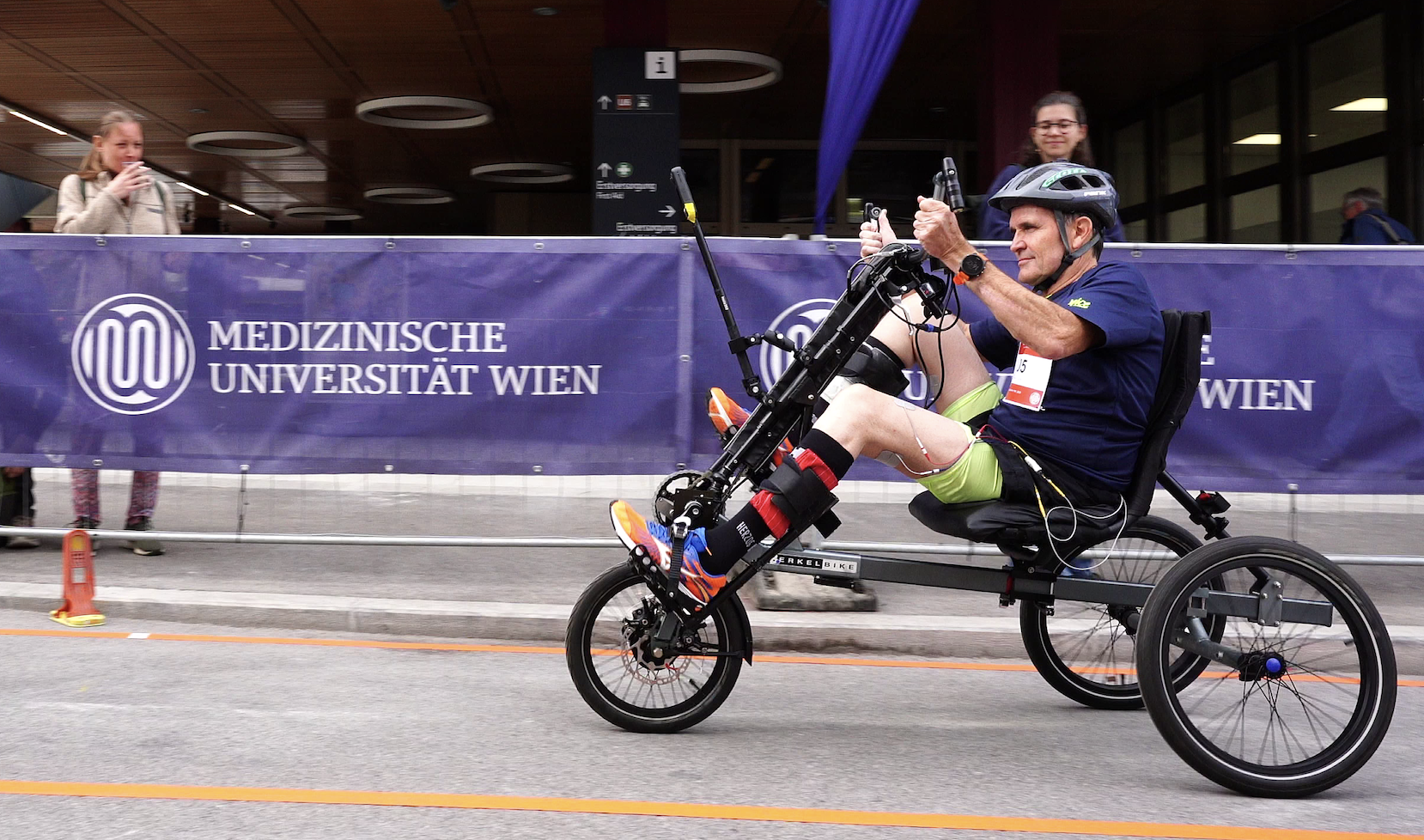
The race format in Vienna:
3 qualifying rounds, semi-finals, and then a 400m final. Each round consisting of three laps of 133m.
The race itself was long, tough, and nerve-wracking. 5 athletes started and both of our athletes made it to the semi-finals. With the final, decided between Austria’s Nikolaus Tellian and Peter van Burk, the start was tense, and both athletes’ legs had already fatigued a bit due to the race distances in the previous rounds. The start atmosphere was tense, especially for Peter van Burk, who was widely seen as the favorite. “I was genuinely nervous,” he admitted later. “If I got the start wrong, I wouldn’t get another chance. Once I was up to speed, I could relax — and hearing the crowd cheer was incredible.”
For his mom, who was watching him race after his accident for the very first time, the moment was unforgettable: “It made me very happy because of the atmosphere — the pilots, the organisation, and being with people who know what a spinal cord injury means. It has a big impact on your life, but you can still live, train hard, want to win, and have fun.”
Final Results & World Record in Vienna
- [NED] Peter van Burk – 01:43.9 min
- [AUT] Nikolaus Tellian – 01:51.8 min
- [AUT] Cedric Kapenberger – 01:55.8 min
- [NED] Peter van Egdom – 04:11.2 min
- [HUN] Csaba Szamosi – TIME OUT
As if winning the 400m was not enough, Peter van Burk went on to set a new world record over 2000m (accessible via Neuroprosthetic Cycling Records) in his second qualification round. His time: 09:19 over 15 laps, with steady splits around 36-38 seconds, and a fastest lap of 35 seconds over 133 metres. The performance and the races were officially validated by independent referee Shant Dayan (Vienna Premedics).
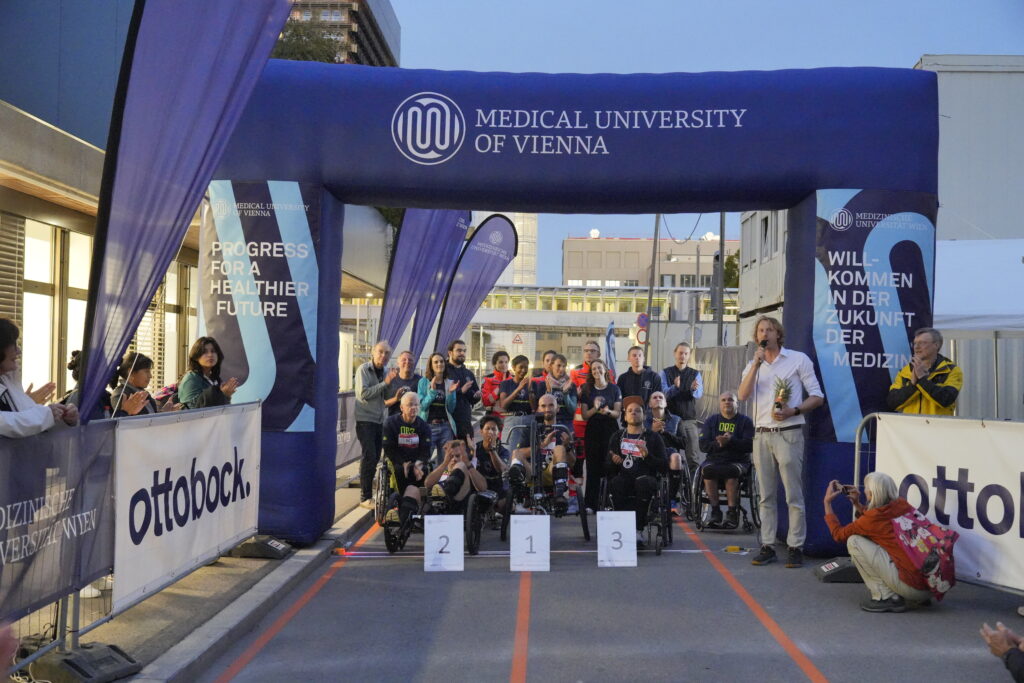
Training That Pays Off
For us, it was not just about the numbers. Attending and winning the FES cycling race showed that the training sessions we have been doing are paying off: the long hours, the tough intervals, the focus on both arm and leg cycling; it all helped our athletes to show an amazing performance during the race.
In the last year, we worked closely with both athletes in the VU lab twice a week, sometimes up to five hours. Peter van Burk’s approach was focused on keeping his heart rate high and combining arm and leg exercise. That approach seems to have boosted his blood flow and performance. Peter van Egdom’s program looked a bit different. For him, the focus was getting used to the resistance and dynamics of riding outside – while only training indoors. His progress from starting to train his legs again in November 2024, starting with just a few seconds of cycling until the muscles fatigued, to his first biking sessions outside in May 2025 – and now finishing 400 meters in just over four minutes. From those first short efforts, to racing full laps in Vienna – his progress itself is something we are all really proud of!
We would like to thank Rik Berkelmans, founder of BerkelBike, who supported us during the race and also provided the bikes to our athletes. BerkelBikes were not designed for competition. They were built for daily use and rehabilitation – but racing has created new challenges and new opportunities. As founder Rik Berkelmans explained: “Lowering the bike or removing features could make it faster, but then many people with spinal cord injuries couldn’t use it. That’s the balance. Competition is healthy, though. It pushes us to improve, not just for racing but for daily life as well.” Racing with these bikes and FES technology means innovation for para-sports – but also, in the long run, better solutions for patients and long term rehabilitation.
Why FES Cycling Matters
FES cycling is more than just racing. For people with spinal cord injuries, it improves blood flow, fitness, and quality of life. It reduces complications and brings back the feeling of movement. As one of our teammates put it: "The event gives visibility outside the FES community and strengthens the connections within it. It sparks curiosity, and it shows that this is not only science - it's also sport, fun, and community." But challenges remain. As Peter van Burk noted: "Rehab professionals see the potential, but the decision-makers often don't. We need to keep showing what's possible." Van Egdom added: "If doctors and insurers don't see the benefits, all our efforts risk staying in a small circle." For Peter van Burk, the record in Vienna is just a beginning. Half a year ago, his VO₂ max (= maximum amount of oxygen your body can use during intense exercise) was measured at 39 ml/kg/min, which is average for a healthy man, but exceptional for a paraplegic. He is convinced he can go further.
For Peter van Egdom, the next step is endurance and more outdoor training: “The start was the toughest part. Which gear, how much stimulation, how to take the corners? Next time, with more practice, I’ll be ready.”
For PULSE Racing, the Vienna Cybersportday marked both an end and a beginning — closing one academic year and opening the next! We will continue focusing on our mission: Making FES accessible to everyone! We stimulate to cycle.
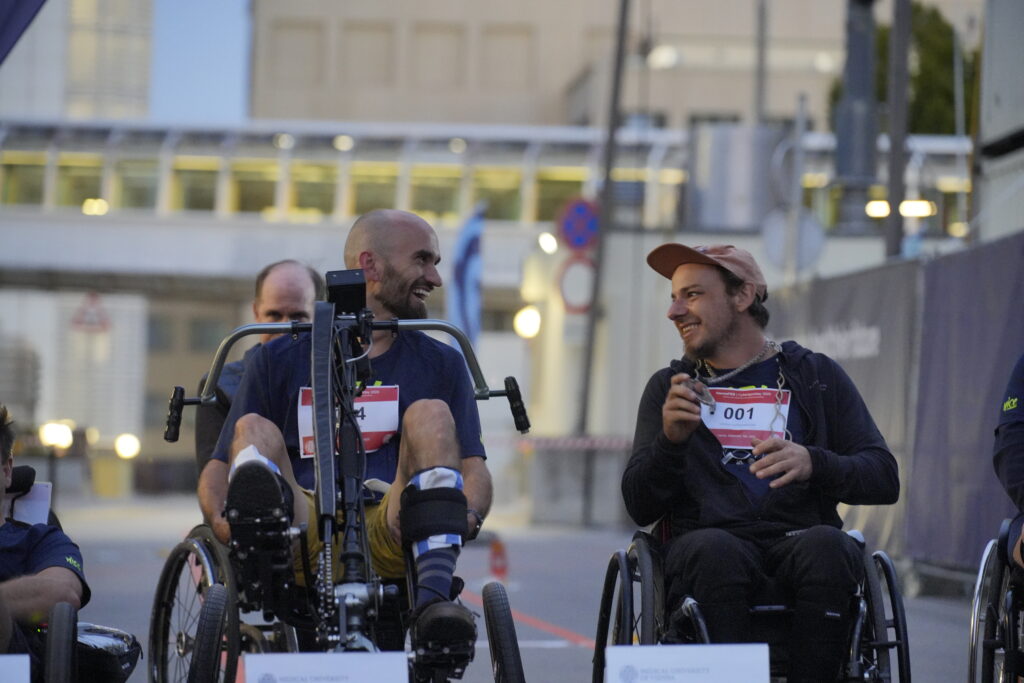
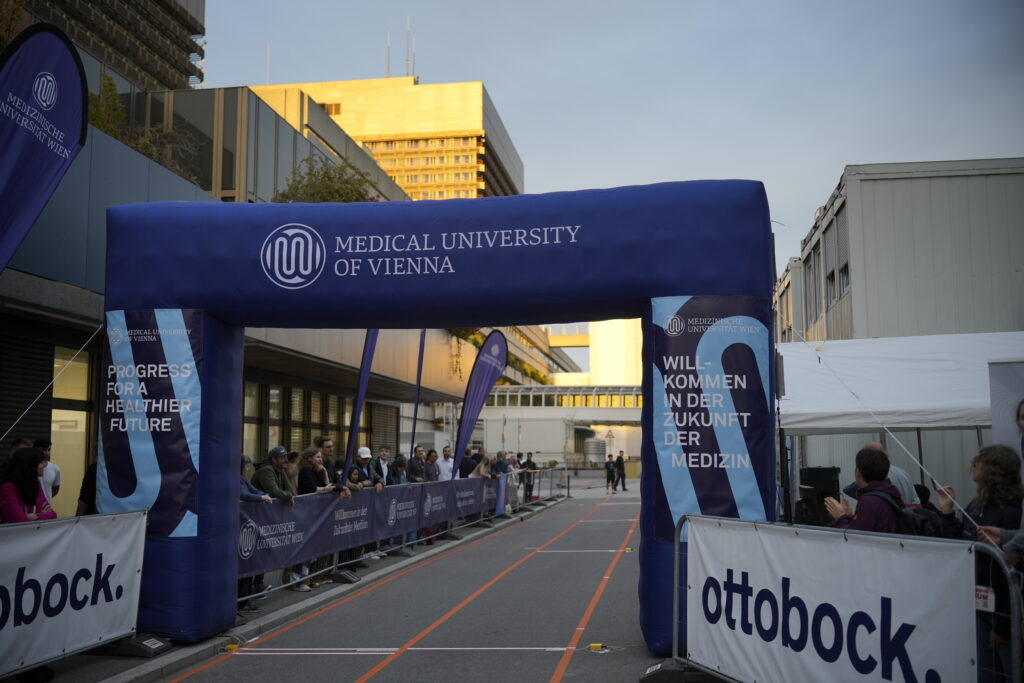
PULSE Racing Athletes: Peter van Burk, Peter van Egdom
PULSE Racing Team supporting in Vienna: Elien Watson, Nadja Spannowsky
Author: Nadja Spannowsky
Photographer: (c) Cristoph Matsch, 2025